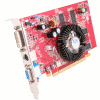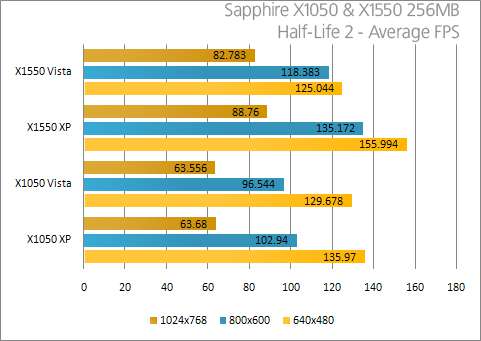- Qualcomm Launches Snapdragon 4 Gen 2 Mobile Platform
- AMD Launches Ryzen PRO 7000 Series Mobile & Desktop Platform
- Intel Launches Sleek Single-Slot Arc Pro A60 Workstation Graphics Card
- NVIDIA Announces Latest Ada Lovelace Additions: GeForce RTX 4060 Ti & RTX 4060
- Maxon Redshift With AMD Radeon GPU Rendering Support Now Available
Sapphire X1050 and X1550

Sapphire has recently launched two new video cards that are designed to deliver you a great Vista experience. Though not touted as gaming cards, they offer enough performance to be worthy of consideration over on-board video.
Page 3 – Installation, Testing Methodology, HL2
Installation of a video card is never difficult, especially with ones of this size. It’s the drivers we are concerned about, especially with Windows Vista. Even though these cards both acknowledge compatibility with Vista, there are no such drivers found on the disc. This is due to the fact that both of the cards were released prior to Vistas launch, so you will be required to grab the 90MB package off the official ATI site.
Installation for Windows XP was simple… as always. However Vista was a little trickier. The process was the same, but before any acceleration could be used, Windows Update had to be used to download specific updates for each card. Once that was done, the OS worked great, as did the Aero interface.
This is where I began Vista testing. The X1050 promised great Aero experiences, so I used the OS for the course of a few hours working on various things, including this review. I’m happy to report that I didnt’ run into a single problem. Aero ran smooth as pie… just as it would with an X1950. I have absolutely no complaints. So in that case, if you are interested in Aero and no gaming, I can already recommend the X1050 to you. The X1550 of course offered the same experiences, with no hitches to mention.
As far as Vista goes, I have no complaints. The most difficult part was downloading the Windows Update fix. That should be kept in mind though, if you do decide to pick up the card. I wasn’t sure of this until I re-installed the driver three times, only to be left completely confused. It was only a last minute ponder that made me decide to check the Windows Updates page. XP didn’t require such an update though… the included drivers on the CD-Rom worked swimmingly.
Throughout all of our benchmarks regardless of what we are reviewing, testing is done in a clean and stand-alone version of Windows XP Professional with SP2. Prior to testing, these conditions are met:
- Desktop and scrap files are cleaned up, including emptying of recycle bin.
- No virus scanner or firewall is installed in the stand-alone installation.
- The stand-alone installation drive is completely defragged using Diskeeper 2007 Professional.
- All unnecessary programs are closed, so that Windows should have no more than 15 active processes running.
- Computer has proper airflow.
The testing rig used for today’s benchmarking is as follows:
- CPU: Intel Q6600 (2.4GHz – 2.85GHz)
- Motherboard: eVGA nForce 680i (P24 BIOS)
- Memory: OCZ 2GB Flex XLC PC2-9200
- Video: ASUS EN8800GTX 768MB
- Sound: Onboard HD Audio
- Storage: Seagate 7200.9 320GB
- Etcetera: Windows XP Professional w/ SP2
- Cooling: Corsair Nautilus 500
(Products linked are to our own reviews)
For our first test, I chose to use one of my personal favorites, Half-Life 2. I performed testing in both XP and Vista to see if one resulted in better or worse performance. All average FPS were recorded using FRAPS 2.8.2. The level I chose to test is one of my favorites in the game, d1_canals_07.
On all resolutions, the X1550 had the clear advantage. However, I admit that the X1050 proved even better than I imagined. It’s definitely not for resolutions above 800×600, however. At certain points during my HL2 run-thru, the game became -very- sluggish, as if I was playing it in slow motion. The X1550 held on tight though. Note that these tests were all done with no AA or AF. Still, for a game like this, 82FPS for a $65 card is not too bad at all.

Let’s wrap up testing with a look at Need for Speed and finally Futuremarks products.
Support our efforts! With ad revenue at an all-time low for written websites, we're relying more than ever on reader support to help us continue putting so much effort into this type of content. You can support us by becoming a Patron, or by using our Amazon shopping affiliate links listed through our articles. Thanks for your support!





